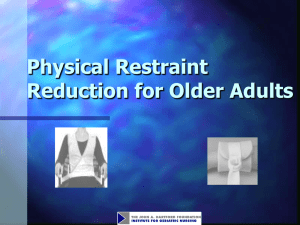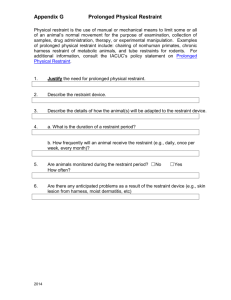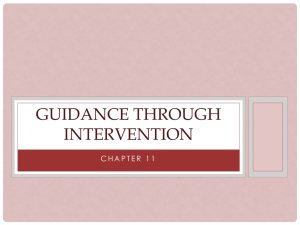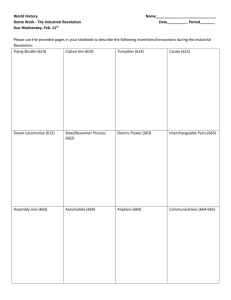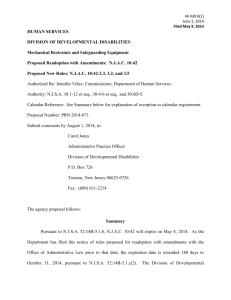An introductory guide to help relatives, friends and carers A restraint
advertisement
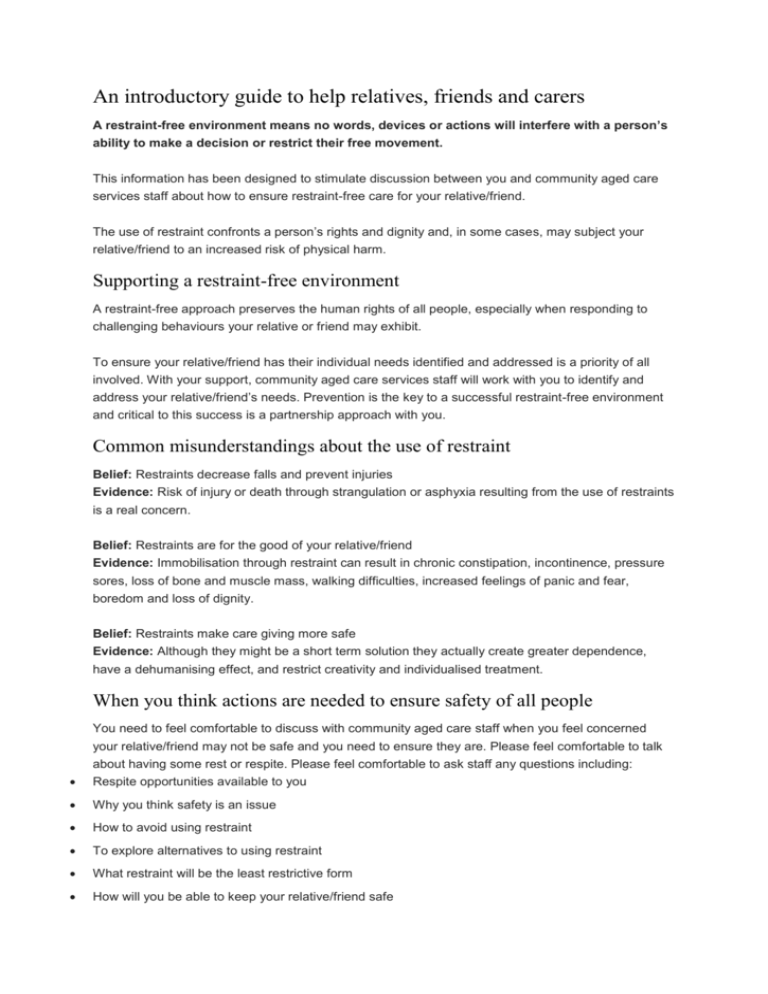
An introductory guide to help relatives, friends and carers A restraint-free environment means no words, devices or actions will interfere with a person’s ability to make a decision or restrict their free movement. This information has been designed to stimulate discussion between you and community aged care services staff about how to ensure restraint-free care for your relative/friend. The use of restraint confronts a person’s rights and dignity and, in some cases, may subject your relative/friend to an increased risk of physical harm. Supporting a restraint-free environment A restraint-free approach preserves the human rights of all people, especially when responding to challenging behaviours your relative or friend may exhibit. To ensure your relative/friend has their individual needs identified and addressed is a priority of all involved. With your support, community aged care services staff will work with you to identify and address your relative/friend’s needs. Prevention is the key to a successful restraint-free environment and critical to this success is a partnership approach with you. Common misunderstandings about the use of restraint Belief: Restraints decrease falls and prevent injuries Evidence: Risk of injury or death through strangulation or asphyxia resulting from the use of restraints is a real concern. Belief: Restraints are for the good of your relative/friend Evidence: Immobilisation through restraint can result in chronic constipation, incontinence, pressure sores, loss of bone and muscle mass, walking difficulties, increased feelings of panic and fear, boredom and loss of dignity. Belief: Restraints make care giving more safe Evidence: Although they might be a short term solution they actually create greater dependence, have a dehumanising effect, and restrict creativity and individualised treatment. When you think actions are needed to ensure safety of all people You need to feel comfortable to discuss with community aged care staff when you feel concerned your relative/friend may not be safe and you need to ensure they are. Please feel comfortable to talk about having some rest or respite. Please feel comfortable to ask staff any questions including: Respite opportunities available to you Why you think safety is an issue How to avoid using restraint To explore alternatives to using restraint What restraint will be the least restrictive form How will you be able to keep your relative/friend safe Restraint-free options to consider review timing of meals/snacks and other activities like showering identify and minimise confusing sensory environments / loud or disliked music avoid sensory overload use signs with pictures around the house to minimise confusion and ensure adequate lighting identify at least one safe wandering area around the house which has easy access ensure there is a private and safe room in the house so that a specific behaviour of concern does not become an issue ask for specific assistance to plan a regular physical activity program ask for specific assistance to plan a possible arts and crafts activity program identify familiar household and/or gardening tasks to keep active stop, look and listen for triggers to changes in behaviours to know when to put in place distraction activities organise with relatives and/or friends planned visiting times and coordinate regular outings if possible The decision to use restraint involves legal issues Legal requirements for consent to use restraint: a family member must have a relevant guardianship order or enduring power of attorney to have the legal capacity to consent to the use of restraint consent might need to be obtained from the Guardianship Board or its equivalent, particularly if the ongoing use of restraint is contemplated service providers should obtain legal advice in cases where there is any doubt about the use of restraint A decision about using the least restrictive form of restraint possible may, as a last resort only, be necessary in situations where a person is doing something that may result in them: harming themselves or others, or experiencing a loss of dignity, or causing damage to property, or disrupting or severely embarrassing family members, friends or neighbours. Prevention of these behaviours will always be a priority, and learning what may trigger any of these will be an ongoing focus of staff’s attention. Further information Aged Care Advocacy Services Australian Capital Territory ACT Disability, Aged and Carer Advocacy Service (ADACAS) 02 6242 5060 (ACT free call number 1800 700 600) ADACAS website New South Wales The Aged-care Rights Service (TARS) 02 9281 3600 (NSW country free call number 1800 424 079) TARS website Northern Territory Aged and Disability Rights Team 08 8982 1111 (NT country free call number 1800 812 953) Darwin Community Legal Service website Queensland Queensland Aged and Disability Advocacy (QADA) 07 3637 6000 (QLD country free call number 1800 818 338) QADA website South Australia Aged Rights Advocacy Service (ARAS) 08 8232 5377 (SA country free call number 1800 700 600) ARAS website Tasmania Advocacy Tasmania 03 6224 2240 or (TAS free call number 1800 005 131 Advocacy Tasmania website Victoria Elder Rights Advocacy (ERA) 03 9602 3066 (VIC free call number 1800 700 600) ERA website Western Australia AdvoCare 08 9479 7566 (WA free call number 1800 655 566) AdvoCare website All information in this publication is correct as at August 2012
